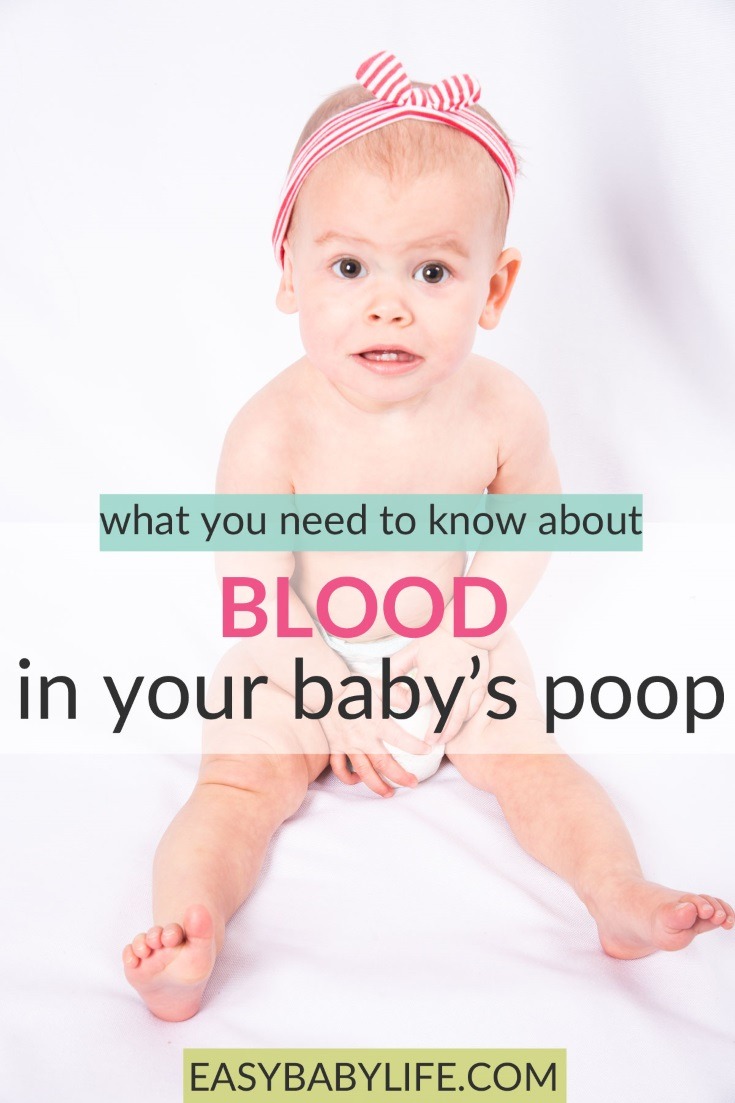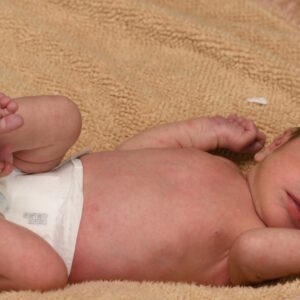
My baby has a lot of blood in his poop. We’ve been to the doctor, but they didn’t explain what it might be, and I didn’t receive any guidance on what to do next. I’m very worried! Please help!
Jade
Possible Reasons For Blood in a Baby’s Stool
First of all, it’s completely understandable that you’re concerned. Good job taking your baby to the doctor! Since you were sent home without a diagnosis, it’s likely the doctor ruled out any severe or immediate concerns. Understanding where in the digestive system each issue originates can help explain different symptoms and blood appearances.

The baby’s digestive system is delicate and still developing. Problems in different areas — from the stomach to the intestines — can sometimes cause blood to appear in stools. For instance, allergies or infections may cause inflammation in the intestines, while swallowed blood from cracked nipples would travel all the way through the digestive tract.
Here are a number of reasons why there might be blood in a baby’s poop:
1. Anal Fissures from Constipation
Blood in a baby’s stool is often not an emergency. One of the most common causes is constipation, which can lead to anal fissures (small tears in the anus) as a result of straining with hard stools. These small tears may cause bright red blood in the diaper. You may notice the blood streaked on the stool or on the baby wipe.
What to Do:
If constipation seems to be the cause, make sure your baby stays hydrated, and if you’ve introduced solid foods, include fiber-rich options like pureed pears or prunes to soften stools. Check with your pediatrician about safe ways to relieve constipation if it’s a recurring issue.
2. Food Allergies
Food allergies, particularly to cow’s milk and soy protein, are another common cause of blood in infants’ stools. Even breastfed babies may experience reactions to these proteins if the mother consumes them regularly. Symptoms of a food allergy can include blood in the stool, mucus, and sometimes other signs of discomfort.
What to Do:
If you suspect a food allergy, consult your pediatrician about eliminating certain foods from your diet (if breastfeeding) or switching to a hypoallergenic formula. Common allergens are cow’s milk, soy, and occasionally egg or wheat.
3. Foremilk Imbalance (Oversupply)
If you’re breastfeeding and have a strong milk supply, your baby may be getting too much foremilk (the watery milk at the start of a feeding) and not enough hindmilk (the richer, more fatty milk at the end). Excess foremilk can lead to lactose overload, which irritates the intestines and sometimes causes blood-tinged stools.
What to Do:
Try feeding from one breast per feeding session to ensure your baby receives more hindmilk. Discuss any concerns with a lactation consultant or your doctor to help manage oversupply.
4. Infections
Some bacterial infections, such as E. coli, Salmonella, or Shigella, can lead to blood and mucus in a baby’s poop. In these cases, additional symptoms like diarrhea, fever, and sometimes vomiting are often present.
What to Do:
If your baby has blood in the stool along with these symptoms, contact your pediatrician promptly. Infections may require specific treatments and can be more serious in young infants.
5. Intussusception
Intussusception is a rare but serious condition in which part of the intestine slides into an adjacent part, creating a blockage. It can cause severe pain and lead to blood and mucus in the stool, often described as “jelly-like”. This condition requires immediate medical attention, but the main sign is usually intense, intermittent pain rather than just blood in the stool.
What to Do:
If you notice a jelly-like stool with blood, especially if your baby appears to be in pain or has other concerning symptoms, seek emergency medical care right away.
Understanding the Color of Blood in a Baby’s Stool
The color of the blood in your baby’s stool can help provide clues about the underlying cause:
Bright Red: Fresh, bright red blood may indicate an anal tear from constipation. In some cases, it may also point to a milk protein allergy if it appears with normal (not hard) stools. Bright red blood with diarrhea could suggest a bacterial infection.
Dark Red or Black (Tarry): If the blood is darker, it’s more likely from higher up in the digestive system. Black, tarry “poppy seeds” suggest digested blood, which can sometimes happen if a breastfed baby swallows blood from cracked nipples. Large amounts of black or dark red blood may indicate a more serious issue that needs medical attention.
Jelly-Like, Dark Red or Bright Red: Stool with a jelly-like texture and blood can indicate intussusception or other infections. This appearance warrants an immediate visit to the emergency room.
When to See the Doctor Again:

If you see blood in your baby’s stool and it’s not due to constipation or if it’s paired with other symptoms like fever, vomiting, or pain, visit a doctor for further evaluation. Trust your instincts—if something feels off, seek a second opinion. Pediatricians are there to help you understand and support your child’s health.
In Summary:
Blood in a baby’s stool can be alarming, but the cause is often mild and manageable. However, it’s essential to monitor the situation closely and consult a pediatrician if the blood persists or is accompanied by other symptoms.
Good luck, and remember: as a parent, you know your baby best. Don’t hesitate to advocate for further answers if you’re concerned.
Read Next
- Baby Not Pooping: How To Tell If They’re Constipted
- Baby Urinating Blood
- Blood Found In The Diaper – Possible Reasons
- Baby Poop Colors That May Actually Be Normal (Stool Color Chart Included)

Research References
- Red Stools in Children: Common Causes
- Food Allergy – National Institute of Health
- La Leche League, Breastfeeding Information: Oversupply
- Cleveland Clinics, Rectal Bleeding
Note: This information is intended to provide a general understanding and is not a substitute for professional medical advice. Always consult with a healthcare provider for concerns about your baby’s health.

Paula Dennholt founded Easy Baby Life in 2006 and has been a passionate parenting and pregnancy writer since then. Her parenting approach and writing are based on studies in cognitive-behavioral models and therapy for children and her experience as a mother and stepmother. Life as a parent has convinced her of how crucial it is to put relationships before rules. She strongly believes in positive parenting and a science-based approach.
Paula cooperates with a team of pediatricians who assist in reviewing and writing articles.







PINK REDDISH STOOL IS COMING ..MY KID AGE IS 23 MONTHS …first vomiting is coming and after that we took into doctor and they said stool was blocked in side that’s y they have given one syrup after onwards stool is coming in pink red colour …is it danger…please give me rwply
Hi,
In general, brighter reddish blood in the stools is less of a warning sign than dark red och black blood, since the latter may indicate internal bleeding. But I think you should definitely check with the doctor who treated your child. Only they will know if the pink-red color is a concern or not. Much better to check one time too many.
Good luck!
My baby had the same thing and it turns out that she has a milk protein intolerance. I breastfeed her exclusively so I had to stop eating all dairy products including anything that has whey or casein in it.
Some babies can’t process the larger cow’s milk protein so it makes them really sick. Our baby used to scream and scream when pooping. This happened especially at night and then she started having blood at about 6 weeks so I was very concerned.
We scheduled an appointment with a pediatric G.I. specialist just in case that wasn’t the problem, but after about a month of me going off dairy, our baby was significantly better. The blood went away after about a week of no dairy.
Definitely, find a doctor that can help you find out what is causing the blood, though. It is serious. We had to change doctors also.
In my 2 years son little blood coming in stool . But he is very active and no pain . He used to drink more milk in a day . What was the exact reason for this cause . can any one help me to resolve the cause . And I given my baby stool to the lab to test and I’m waiting for the result
Hey
My 20 months old has same issues. Blood and mucus in poops. Doctors said it’s infection and will b resolved in 7 days.
How is your son doing?
My five months old baby had blood in her poop this week. But I noticed some tear at her anus area.